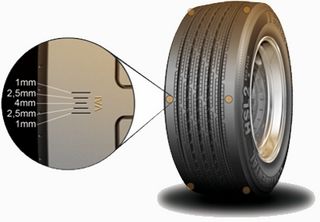Tyre wear
1. Legal tread pattern depth and wear indicators.
The European regulations require a minimum tread pattern depth that allows efficient water drainage by the tyre. It can vary from country to country. Usually, the minimum depth is 1.6mm.
Most tyres feature tread wear indicators located on the grooves of the tread. They allow the driver to know when they should replace their tyres.

Other methods are available to check the tyre wear :
- The digital tread wear indicator consists in digits engraved on the tread that rub off progressively.
- Colour change. The internal rubber changes to bright orange to indicate the tyre is worn out.
- The depth gauge ( this tool can be bought in all garages)
2. Tyre wear : diagnose the problems
It is important to know how to recognize the possible causes of abnormal tread wear. Very often, it is due to incorrect pressure (under or over inflation) but other factors (mechanical problem parallelism, balancing, suspension, transmission) can also cause early, abnormal tread wear.
| Tread wear problems | Causes |
|---|
The shoulder blocks (at the extremities of the tread) wear out faster than the centre tread.
 |
Under-inflation |
| The tyre have not been rotated for a long time. |
| Cornering at speeds that are too high. |
| Poorly suited wheels and tyres. |
The centre tread wears out faster than shoulder blocks.
 |
Over-inflation |
| Poorly suited wheels and tyres. |
| The tyre have not been rotated for a long time. |
One side of the tyre displays abnormal wear.
 |
The tyre have not been rotated for a long time. |
| Incorrect tyre alignment , geometry and parallelism problem. |
One or several spots on the tread display abnormal wear.
 |
Problem with the suspension and transmission. |
| Incorrect tyre balancing |
| Braking or acceleration are too abrupt. |
| Under-inflation |
Diagonal wear
 |
Incorrect wheel alignment, geometry and parallelism problems. |
| Under-inflation |
| The tyre have not been rotated for a long time. |
| Incorrect tyre balancing |
3. Assets of the VAI (Visual alignement indicator).
Abnormal tyre wear may be caused by incorrect parallism. The visual alignement indicator (VAI) is a system that makes it easier to recognize a parallelism problem and to check tyre wear without an electronic measuring device. The VAI is made up of five rubber bars located on the shoulder block. After a few thousand miles, you just have to compare the indicators which are from one to four milimeters deep to check whether the wear on both sides of the shoulder matches the wear of the wheel on the other side of the axle.

Breaking in
Do I have to break in my tyre?
Yes, it is important to break in your tyre. During the first 200-400 kms you should drive at moderate speeds.
Each tyre behaves differently according to the its brand and tread pattern. Take the time to adapt to your new tyres.
As a consequence, avoid hard braking and acceleration in the beginning.








